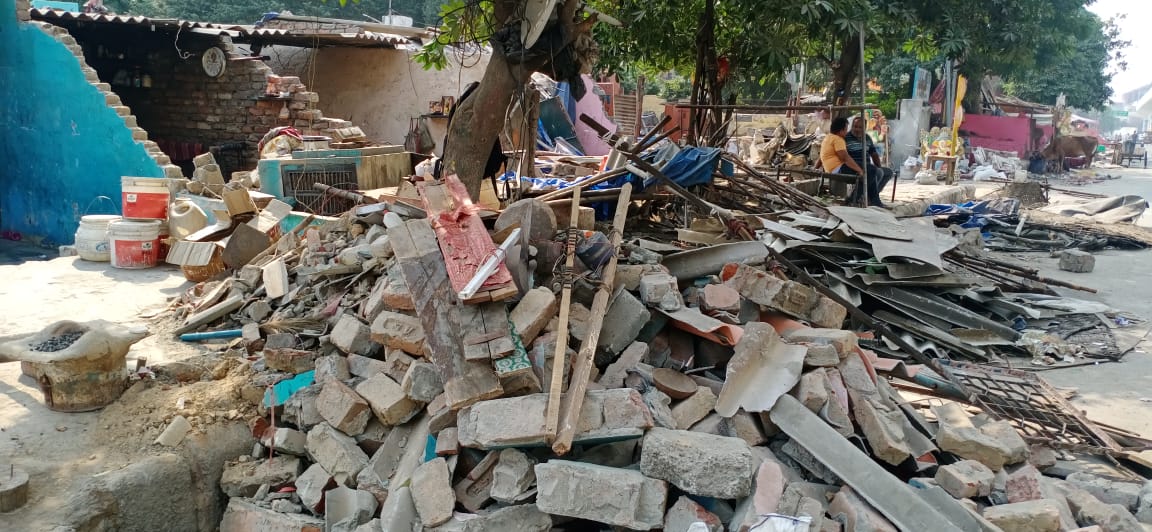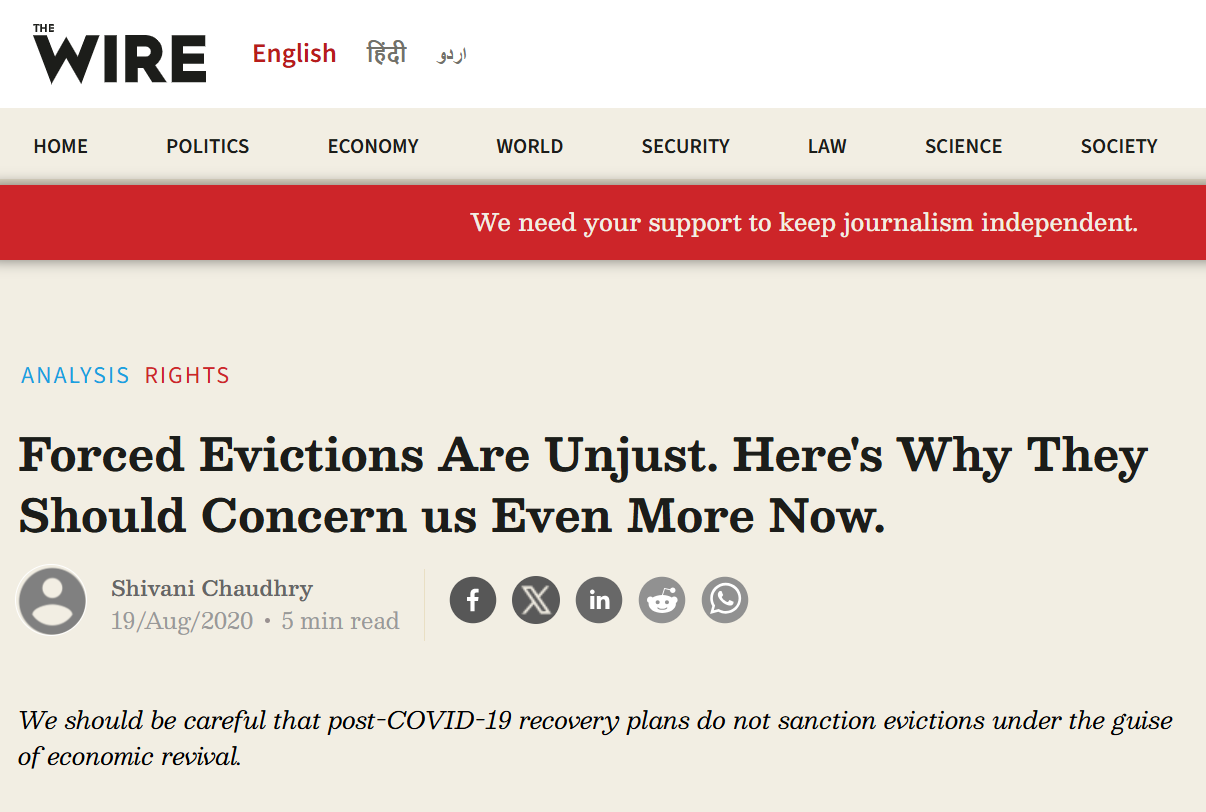Forced Evictions Are Unjust. Here's Why They Should Concern Us Even More Now.
Published by THE WIRE
[Author: Shivani Chaudhry | Date Published: 19 August 2020]
Children shriek and adults rush about, trying to gather
their belongings. You cannot fathom what is happening. You have lived in this
house for 20 years. Built it over time, with hard-earned savings. It is small,
just a room-and-a half. And in a matter of a few hours, it is gone.
Your home, your possessions, everything you have collected
and saved, reduced to rubble. And now you are out on the streets.
Hard
as it might be to imagine, this is what over 568,000 people in urban and rural
India have gone through over the last three years – forced evictions
and demolition of their homes.
The Housing and Land
Rights Network (HLRN),
through its National Eviction and Displacement Observatory, just released a
comprehensive report on forced evictions in India.
The
study found that central and state government authorities demolished over
177,700 houses in 2017, 2018, and 2019, which means that at least
519 people lost their homes daily, with almost five homes being destroyed
hourly, or about 22 people being evicted every hour.
Furthermore,
nearly 15 million people across India
currently live under the threat of displacement. Though deeply disturbing,
these figures are conservative, as they only reflect cases known to HLRN, and
thus present a partial image of the true scale of this grave but unreported
national crisis.
These
numbers should shock us, but we need to remember that these are not mere
statistics. These are real people – men, women, children, older persons,
Dalits, Adivasis, and persons with disabilities. People who have lost not just
their homes and sense of safety and security but also their livelihoods,
income, health, and very often their education, and prospects of a better
tomorrow for themselves and their families.
Forced evictions ensure the entrenchment of poverty. They
result in increased impoverishment and income and social inequality in society.
They violate national laws, policies, and schemes. They contravene
international human rights obligations. They go against humanity.
Despite
the fact that affected persons suffer extensively and sometimes even lose their
lives during or in the aftermath of eviction drives, and that laws and human rights standards are infringed, no action is taken against
those responsible for such evictions.
The COVID-19 pandemic has ripped the mask
off several flawed public policies and revealed major social protection gaps
around the world. A significant global realization has been that adequate
housing is critical for people’s health, safety, and lives. Secure housing has
been recognized as a means of prevention and adequate recovery from the
coronavirus. The mantra to stay well is ‘stay home.’
Not paying heed to this call,
even during the pandemic, state authorities in India forcibly evicted at least
20,000 people from their homes (between March 16 and July 31, 2020), as
recorded by HLRN. During this critical public health emergency, for a state to
continue the brutal demolition of homes of low-income communities is not just a
violation of human rights law but is also inhumane and indefensible.
India already has among the world’s highest
number of people living in homelessness, with over four million homeless people
in urban areas, and over 75 million people living in urban settlements in
insecure housing without access to essential services.
Instead
of focusing on improving their living conditions and actualizing the ‘housing
for all by 2022’ slogan, the government continues to demolish homes and evict
people without due process, including prior notification and resettlement. In
only 29% of the incidents of eviction in 2018 and 2019 for which information is
available, was some form of resettlement provided by the state.
The overwhelming majority of affected persons are left to fend for themselves; a large number is rendered homeless. For those who receive alternative housing, the relocation sites are generally remote and devoid of adequate housing and civic and social infrastructure facilities.
Evictions Under Various Guises
Evictions
in India are carried out under various guises, the most common being ‘slum’
clearance or removal of ‘encroachments’ and ‘beautification.’
Over the last three years, 46%
of those evicted, at least 262,400 people lost their homes for this reason. The
inherent assumption that low-income communities are ‘encroachers’ on public
land and that ‘beautification’ implies getting rid of them is deeply
discriminatory and problematic.
Another
reason increasingly being used to clear people—mostly indigenous/tribal communities—out of
their habitats is ‘forest protection’ and environmental projects (17%). Such
evictions are based on the fabricated binary between people and the
environment, being projected by certain conservationists and often supported by
the judiciary.
Under
the guise of ‘disaster management’ too, lands are being cleared of the poor in
cities like Chennai. But the location of alternative sites in low-lying,
flood-prone areas brings into question the real reason for these evictions.
Euphemisms
like ‘resettlement’ and ‘relocation’ are being used to promote segregation and
spatial inequality, especially in urban areas across the country, but in
reality these are state-sponsored dispossession exercises gaining sanction in
official policies.
Greatly
disconcerting is the lack of access to justice and effective remedy for
affected persons. Courts, in several instances, have been responsible for
authorizing evictions. Research by HLRN reveals that in 2019, over 20,500
people were evicted as a result of court orders, including of the National
Green Tribunal. Where the judiciary has recognized the unlawfulness of
evictions, orders are mostly in the form of stays on further evictions; they
generally do not provide relief and restitution of the rights of affected
persons.
In cases where progressive
judgments upholding the right to housing have been issued by courts, the state
is delinquent in not implementing them. Orders calling for evictions, however,
are immediately executed, again revealing deep-set prejudices against the poor
and their habitations.
Despite
the alarming scale and magnitude of this phenomenon, the issue of forced
evictions is not discussed in the legislature or bureaucracy, not spoken about
in most policy circles, and not documented. No official data on evicted or
displaced persons exists in India. If such a serious human rights emergency is
not recognized in the country, how can we hope for adequate policy response let
alone justice for the thousands of affected persons and the millions living
under threat of eviction?
But
when the state renders people homeless, why is that not recognized as a human
disaster? All evicted or displaced and homeless persons must receive priority
attention, including in allocation of housing and adequate rehabilitation. India should promulgate a ‘right to housing’ law,
upholding housing as a human right and guaranteeing tenure security, as
well as a ‘right to homestead’ law to allocate land for housing and subsistence
livelihoods to landless and homeless people.
We should be careful that post-COVID
recovery plans do not sanction evictions under the guise of economic revival,
as that would result in further distress and setbacks. Any country that cares about economic and social justice, and is
serious about meeting its legal obligations, must ensure everyone’s right to
live in peace, security, safety, and dignity, which inherently requires ending
forced evictions.
===









Comments
Post a Comment